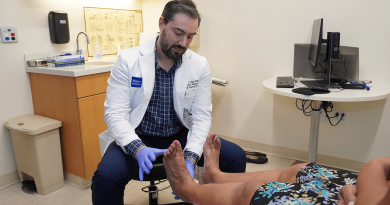How video review enhances surgical care, education and performance improvement

In the world of professional sports, athletes don’t step onto the field without studying footage. Football players review game tapes to analyze their own performance and that of the opposing team. This practice sharpens their skills and helps them make better decisions under pressure. According to Dr. Ryan P. Dumas, associate professor of surgery in the Division of Trauma and Acute Care Surgery, trauma surgery teams benefit from a similar approach.
Every second counts in the resuscitation room, and actions and decisions can mean the difference between life and death. Trauma surgeons manage patients who have experienced blunt trauma – such as falls, car accidents or workplace incidents – or penetrating trauma, like gunshot wounds or stabbings. The challenge lies in making life-or-death decisions with very little information in high-acuity settings. Dumas highlights the value of video review in these scenarios, explaining how it helps teams learn from their performance.
“I think we would be silly not to watch our teams perform and improve,” Dumas said. In peer-reviewed conferences, trauma surgeons pull up video recordings of procedures and discuss areas where care could be improved or instances where it went well. This method brings a new dimension to performance improvement, offering insights that traditional medical records cannot capture. “Medical records only capture about 50% of what happens,” Dumas said. “Even then, they don’t convey the tone or chaos of a situation. Teams can learn a lot from a video review of what happened versus the medical record.”
Dumas compares the limitations of medical records to a coach trying to assess a football game without watching footage. “The coach could say what plays were called, but that doesn’t show what actually happened on the field.” The analogy underlines the importance of video technology in trauma care, where the stakes are high and the environment is unpredictable.
Some naysayers are worried about privacy laws such as HIPAA or that recordings could be used punitively. However, Dumas says patient privacy is still protected as the recordings are used for learning and are not released publicly. He also says the videos are not about individual surgeons, but about how the team performs as a whole.
Dumas has done a lot of research on video for trauma review and has found that teams often realize they are not performing as well as they thought – an important lesson, as self-perception is rarely an accurate reflection of reality. “Everyone thinks they’re better than they are,” he says. “But the video doesn’t lie.”
Video reviews help identify areas for improvement that may not be obvious from medical records. For example, Dumas mentions that one in three intravenous (IV) placements fail, and some trauma teams take up to 10 minutes to insert a chest tube. Still, neither of these details would be in the electronic medical record. By replaying footage, teams can analyze specific details, such how long it took to perform a critical procedure.
The potential of video review goes beyond identifying errors. “Sometimes videos show what to do, not just what went wrong,” Dumas said. “Video technology allows trauma teams to fine-tune their skills and enhance patient outcomes, much like a football player watching game tape to improve gameplay and technique.”
In trauma surgery, where quick decisions are made with incomplete information, video review offers a powerful tool for process improvement. “Trauma invented process improvement,” Dumas said. “We make difficult decisions with little information. Being self-reflective is key.”
Trauma video review also can support other quality improvement efforts, including peer-review conferences, root cause analyses and grand rounds. When used regularly in structured review sessions, it fosters data-driven discussions and drives meaningful improvements in trauma care.
Dumas hopes to see the use of trauma video review continue to increase, leveraging the clarity and precision that video provides to improve the way trauma teams deliver care continuously.
By Tiffany Harston, senior communications associate in the Michael E. DeBakey Department of Surgery



